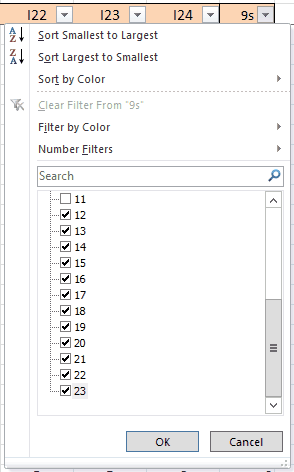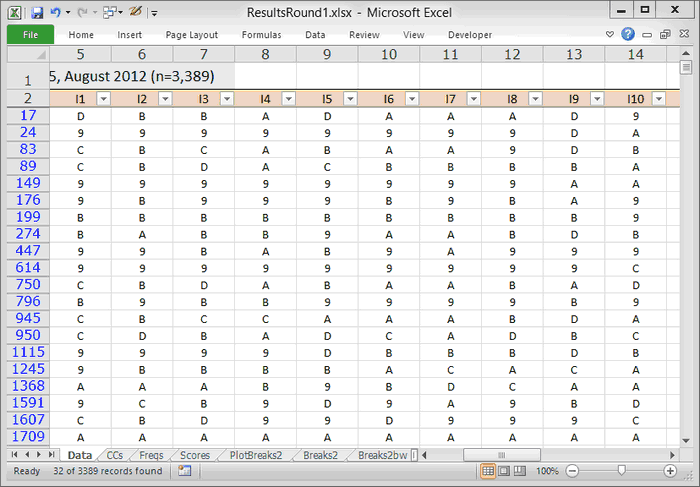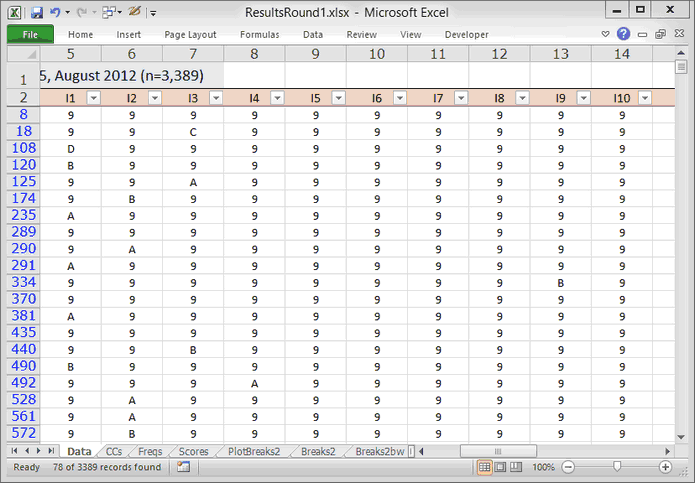Lots of 9s?
This topic is devoted to the first two of my questions.
1.How many students have lots of 9s? As there are 24 items, I'll say that "lots of 9s" will mean any student with at least twelve 9s, half the number of items.
2.Is there any apparent pattern to the 9s? If students find the item to be difficult, many times the 9s will come towards the end -- the students run out of time and are unable to take a stab at all questions.
Remember that my 9s are found in column 29 of the Data worksheet. I'll use Excel's Filter tool on this column, as seen here:

Excel reports that there are 485 records having from twelve to twenty-three 9s. This is about 14% of the total number of students. To me, this is indeed "lots of 9s".
What about a pattern? Is it the case that students start to answer the items, but then, for some reason, stop?
To answer this question, I'm going to use Filter to look at those students who have just twelve 9s.
Filter reports that there are 32 students who left twelve items unanswered.
Have a look at the first ten item responses for the first twenty of these students:

Of the twenty students seen in this screen capture, eight have a 9 on the first item, I1 (column 5).
Look at the last record, row 1709. This student started out selecting option A on the first twelve items, after which he or she left the remaining twelve items unanswered. (No, that's right, you can't see this by looking at the screen snapshot above as I've only snapped the first ten columns. But trust me; I used to sell used cars.)
Look at the first record, row 17. This student appeared to make a good start at answering the items: the first nine questions were all answered. However, the student did not answer the next seven items (I10 through I16). Then, he or she did answer I17, I18, and I19, but left all remaining items unanswered.
A few students left initial items unanswered, but then, for some reason, began to answer the questions. See, for example, rows 24,149, 614, and 1115.
I do not see a pattern here. Things are helter-skelter.
I'll do one more thing: get Filter to show responses for all those students who did not answer twenty-three of the items. Here are the first twenty of seventy-eight records identified by Filter:

What I would understand is students answering one of the first three items, and then giving up. Quite a few of these students did that (for example, rows 108, 120, 125,174, 235, 290, 291, 381, 440, 490, 528, 561, and 572). However, some students didn't provide their answer until well into the questions (8, 289, 334, 370, and 435).
Next, I'll drill down with these results. There were seventy-eight students who answered just one item (that is, had a 23 in column 29). I'll ask Filter to tell me how many of these answered the first item. Answer = 12. How many answered the second item? Answer = 32. How many answered the third item? Answer = 7. This is a bit better if I'm looking for a pattern: 51 of the 78 students who answered just a single item did so early in the test -- they gave it a bit of a go at the start, and then appeared to give up (which is what we might expect). Still, 27 of these students left the first items unanswered.
I'll come back to my questions:
1.How many students have lots of 9s? As there are 24 items, at the start I'll say that "lots of 9s" will mean any student with at least twelve 9s, half the number of items.
2.Is there any apparent pattern to the 9s? If students find the items to be difficult, many times the 9s will come towards the end -- the students run out of time and are unable to take a stab at all questions.
Yes, there were lots of 9s. About 14% of the students, 485 of them, did not answer at least half of the items.
There wasn't a clear pattern to me except, possibly, among those seventy-eight students who only answered one of the 24 items. The majority of these students, 51 of 78, gave their answer on one of the first three items. They seemed to give it a whirl at the beginning of the test, but quickly surrendered.
